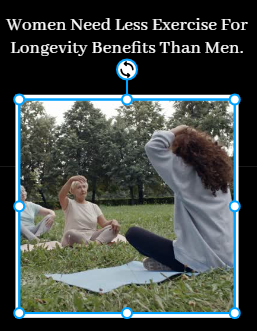By Joe Boland
May 9, 2024
A new study has unveiled a surprising revelation: Women may need only half the amount of exercise as men to achieve similar benefits in terms of longevity. This groundbreaking research challenges conventional wisdom and underscores the importance of personalized approaches to physical fitness based on gender differences.
As the world grapples with rising concerns over sedentary lifestyles and their impact on health outcomes, these findings offer invaluable insights into optimizing exercise regimens for women.
The study also revealed that women who engage in regular physical activity may significantly extend their life spans. The findings, published in the Journal of the American College of Cardiology, shed light on the vital role of exercise in promoting longevity among women.
As the global population continues to age, these insights underscore the importance of prioritizing physical fitness for overall health and well-being.
Study Findings
The researchers describe their methods for this study as follows: “In a prospective study of 412,413 U.S. adults (55% female, age 44 ± 17 years) who provided survey data on leisure-time physical activity, we examined sex-specific multivariable-adjusted associations of physical activity measures (frequency, duration, intensity, type) with all-cause and cardiovascular mortality from 1997 through 2019.”
Focusing specifically on the relationship between exercise habits and life span among men and women, the findings yielded compelling results.
Contrary to previous assumptions, the study revealed that women may require significantly less exercise to reap the longevity benefits associated with physical activity. The current guidelines recommend a minimum of 150 minutes of moderate-intensity exercise per week for adults, and the research suggests that women who engage in 140 minutes of weekly exercise saw the same benefits for longevity as men who did 300 minutes of aerobic exercise weekly.
Specifically, the study found that men who reached 300 hours of aerobic exercise per week had an 18 percent lower risk of death compared to sedentary men. Meanwhile, the risk of death was 24 percent lower for women who exercised for 300 minutes per week compared to women who did not exercise, and women who exercised 140 minutes per week saw an 18 percent lower risk of all-cause mortality compared to sedentary women — the same percentage as men who worked out more than twice as long.
The study authors also noted that both men and women saw a plateau in longevity benefits beyond 300 minutes of weekly exercise.
As noted in an article from Time, “The researchers ran a similar analysis on muscle-strengthening exercise, such as weight training. They found the same pattern: for women, a single weekly strength-training session was associated with just as much longevity benefit as three weekly workouts for men.”
The study further elucidated the underlying mechanisms driving this disparity, citing potential differences in physiological responses to exercise between men and women. For instance, study co-author Dr. Martha Gulati, director of preventive cardiology at Cedars-Sinai in Los Angeles, told Time that since women generally tend to have less muscle mass then men, “if they do the same amount of strengthening exercises, they may have greater benefits with smaller doses just based on the fact that they don’t have as much to begin with.”
While further research is needed to fully confirm these mechanisms, the findings underscore the importance of tailored approaches to promoting physical activity among diverse populations.
How to Add More Exercise for Longevity
For women (and men) seeking to enhance their overall health and longevity through exercise, experts recommend a multifaceted approach that prioritizes consistency and enjoyment. Simple yet effective strategies include:
- Set Realistic Goals
Start with achievable goals, and gradually increase the duration and intensity of your workouts over time. Whether it’s aiming for a certain number of steps per day or dedicating specific time slots for exercise, establishing realistic targets can help maintain consistency.
- Explore Various Activities and Find Activities You Enjoy
Experiment with different types of physical activity to discover what resonates with you. Whether it’s dancing, hiking, swimming, team sports or yoga, choose activities that bring you joy and make exercise a sustainable part of your lifestyle. Diversifying your routine can keep workouts engaging and enjoyable.
- Incorporate Movement Into Daily Life
Look for opportunities to incorporate physical activity into your daily routine, like exercise hacks such as taking the stairs instead of the elevator, walking or cycling to work or for short errands, or engaging in active hobbies like gardening or playing with pets.
- Seek Social Support
Joining fitness groups, partnering with a workout buddy or participating in community events can provide valuable social support and accountability, making exercise more enjoyable and sustainable in the long run.
- Focus on Quality Over Quantity
Rather than fixating on meeting specific time-based targets, prioritize the quality of your workouts. Incorporate a mix of aerobic, strength training and flexibility exercises to maximize overall fitness and well-being.
- Listen to Your Body
Pay attention to your body’s cues, and adjust your exercise routine accordingly. Incorporate rest days as needed to prevent overexertion and minimize the risk of injury.


